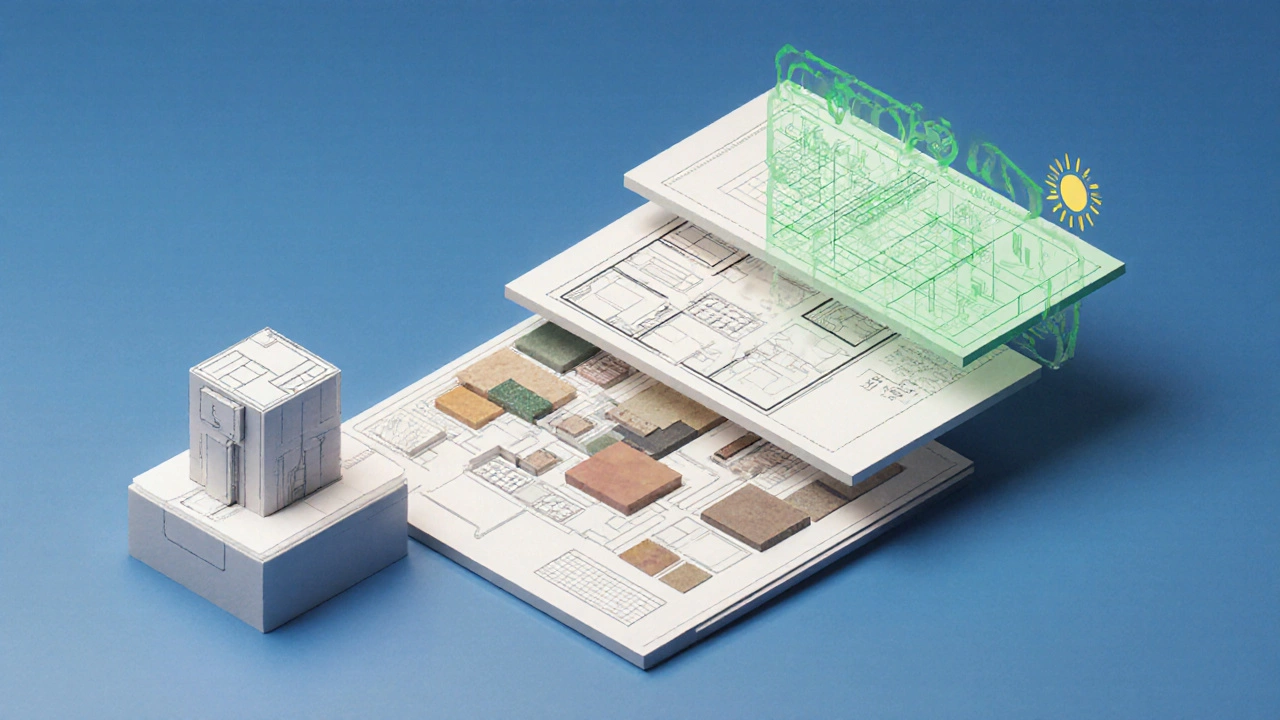Understanding Architectural Services: Definition, Scope, and Benefits
 Oct, 17 2025
Oct, 17 2025
Architectural Fee Calculator
Estimated Architectural Fees
If you're wondering what architectural services really mean, you’re not alone. Many homeowners and developers hear the term but aren’t sure what falls under it, how it differs from general construction work, or why it matters for a successful project.
Key Takeaways
- Architectural services cover everything from initial ideas to construction supervision.
- Core phases include concept design, schematic design, design development, and construction documentation.
- Additional offerings like sustainability consulting and cost estimation add value and reduce risk.
- Fees are usually based on a percentage of construction cost, a lump‑sum, or hourly rates.
- Choosing a qualified architect and understanding the service scope saves time, money, and headaches.
What Are Architectural Services?
When you hear the term Architectural Services is the range of professional activities that architects provide, from initial ideas to construction oversight, you might wonder how it differs from a builder’s job. In short, architectural services focus on the design and planning side of a building project. They answer questions like: How should the space be organized? Which materials best meet the aesthetic and performance goals? How will the design meet local regulations?
Who Provides These Services?
The primary professional is a Architect who holds the appropriate licensing and registration in their region. Architects blend creativity with technical knowledge, bridging the gap between a client’s vision and the practical realities of construction.
Core Components of Architectural Services
Architectural work is usually broken into several distinct phases. Each phase generates specific deliverables that guide the next step.
- Concept Design is a rough sketch of ideas, often expressed through hand drawings or simple 3D models. It helps the client visualize the overall look and feel.
- Schematic Design is a more detailed layout that defines spatial relationships, circulation, and basic dimensions. This stage often includes preliminary material selections.
- Design Development is where the schematic concepts are refined, structural systems are coordinated, and most design decisions are finalized. Engineers and consultants are typically brought in at this point.
- Construction Documentation is the production of detailed drawings and specifications that contractors use to build the project. These documents include plans, sections, elevations, and schedules.
- Project Management is the oversight of design progress, coordination with consultants, and communication with the client throughout construction. Some architects offer full‑service management; others provide limited oversight.
- Sustainability Consulting is advice on energy‑efficient design, material choices, and green building certifications such as Green Star or LEED. It’s increasingly common in New Zealand projects.
- Cost Estimation is a preliminary and later refined estimate of construction costs, helping clients budget accurately.
- Regulatory Compliance is ensuring the design meets local building codes, fire safety rules, and zoning requirements, often involving the preparation of a Planning Permission application.

Typical Service Flow
- Initial Consultation - The architect learns about the client’s goals, budget, and site constraints.
- Site Analysis - Review of topography, climate, and local regulations (often with a town planner).
- Concept Design - Quick sketches to explore options.
- Schematic Design - Refined layouts with basic dimensions.
- Design Development - Detailed plans, structural coordination, material selections.
- Construction Documentation - Full set of drawings and specifications.
- Bid & Contractor Selection - Architects may help evaluate contractor proposals.
- Construction Administration - Site visits, submittal reviews, and issue resolution.
- Project Close‑out - Final inspections, as‑built drawings, and handover documents.
How Architects Charge for Their Services
Fee structures can vary, but the most common approaches are:
- Percentage of Construction Cost - Typically 7‑12% for residential projects; the rate drops for larger commercial builds.
- Lump‑Sum Fee - A fixed amount agreed upon after the scope is defined, useful when the project budget is tight.
- Hourly Rate - Often used for small consulting tasks or when the client only needs advice on specific issues.
Many architects also combine methods, such as a lower percentage plus hourly rates for change‑order work.
Benefits of Hiring an Architect
Choosing a qualified professional brings several tangible advantages:
- Design Quality - Architects balance aesthetics, functionality, and durability.
- Regulation Navigation - They know the Building Code, local council requirements, and can fast‑track approvals.
- Cost Control - Early design decisions avoid expensive re‑work later on.
- Value Engineering - Architects suggest materials and systems that lower long‑term operating costs.
- Project Coordination - They keep engineers, contractors, and clients in sync, reducing delays.
Choosing the Right Architectural Service Provider
Not every architect offers the same suite of services. Here’s a quick checklist to help you decide:
- Is the firm licensed in your region (e.g., New Zealand Registered Architect)?
- Do they have experience with projects similar in size and type?
- Can they provide references or a portfolio of completed works?
- What is their fee structure and does it fit your budget?
- Do they offer the additional services you need, such as sustainability consulting or full project management?

Common Pitfalls to Avoid
Even with a great architect, mistakes happen if you’re not vigilant. Watch out for these:
- Scope Creep - Adding tasks without adjusting the contract can blow up costs.
- Poor Communication - Regular meetings and clear documentation prevent misunderstandings.
- Skipping the Design Development Phase - Rushing to construction documents often leads to change orders.
- Ignoring Local Regulations - A design that looks great on paper might be rejected by the council.
Quick Reference Table
| Service | Phase | Main Deliverable |
|---|---|---|
| Concept Design | Initial | Sketches / 3D massing model |
| Schematic Design | Early | Floor plans, basic elevations |
| Design Development | Mid | Detailed drawings, material specifications |
| Construction Documentation | Late | Full set of construction drawings, schedules |
| Project Management | Throughout | Site reports, coordination meetings |
| Sustainability Consulting | Optional | Energy model, certification pathway |
| Cost Estimation | Optional | Pre‑construction cost forecast |
| Regulatory Compliance | Optional | Planning Permission, code compliance reports |
Next Steps
Ready to start your project? Begin by gathering a list of your goals, budget, and site information. Then reach out to a few local architects, request their portfolios, and discuss how they would approach each phase. A good initial meeting should be free and give you a clear sense of how they communicate and whether they understand your vision.
Frequently Asked Questions
What exactly does an architect do that a builder doesn’t?
An architect creates the design, ensures it meets all codes, prepares detailed drawings, and often oversees construction. A builder focuses on executing those drawings, managing trades, and delivering the finished structure.
Do I need architectural services for a small home renovation?
If the work changes the building’s structure, footprint, or involves new electrical/plumbing layouts, a licensed architect is usually required. Even for interior remodels, an architect can add value by improving space flow and ensuring compliance.
How are architectural fees calculated in New Zealand?
Most architects charge a percentage of the estimated construction cost, typically 7‑12% for residential projects. Larger commercial projects may see rates drop to 5‑7%. Some firms also offer lump‑sum or hourly rates, especially for consulting-only tasks.
Can I hire an architect just for a feasibility study?
Yes. Many architects provide a “concept study” that includes basic massing, site analysis, and rough cost estimates. This helps you decide whether to move forward before committing to full design development.
What is the role of sustainability consulting within architectural services?
Sustainability consultants work with the architect to select energy‑efficient systems, choose low‑impact materials, and guide the project toward certifications like Green Star. Their input can reduce long‑term operating costs and improve occupant comfort.
